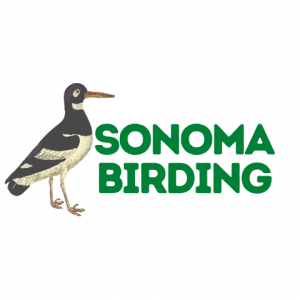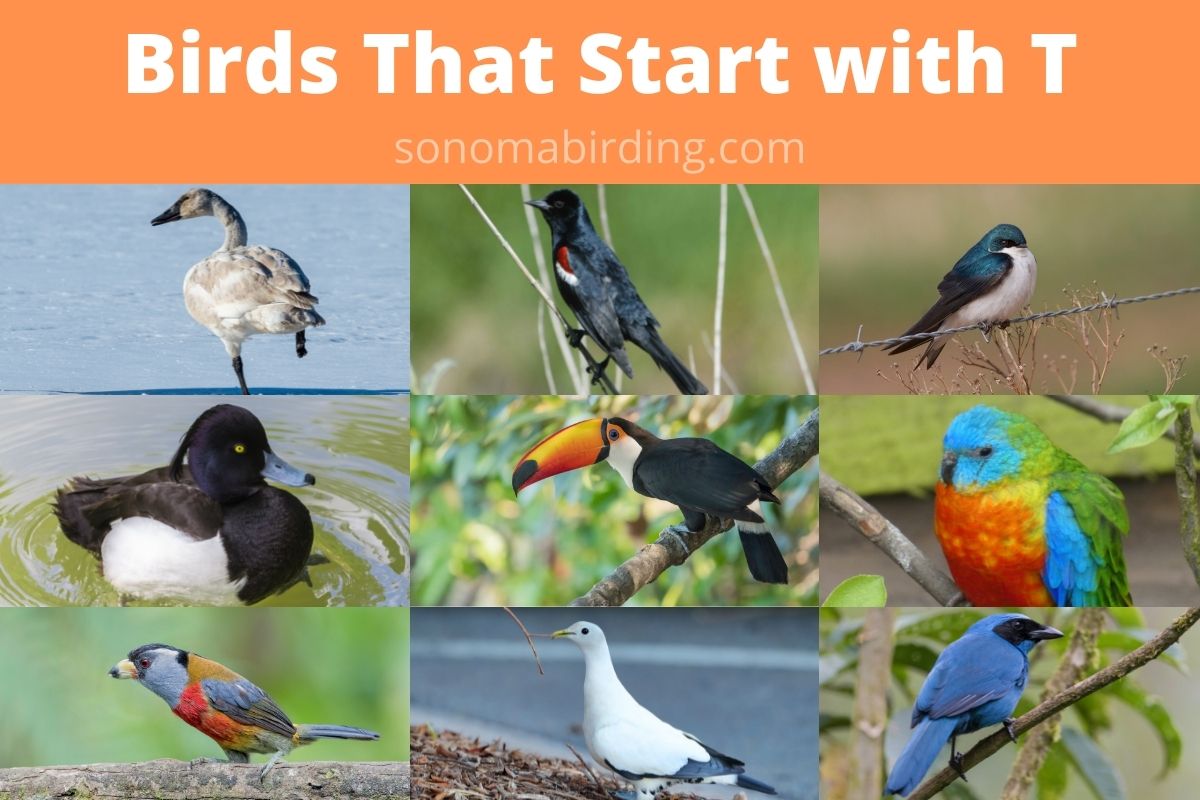I love birds. Not just because they are beautiful creatures that serve as symbols of freedom and peace across all cultures, but because they are just darn cute. Also, I don’t know why but I can’t help but smile when I notice that certain birds always seem to start with the letter T.
Here is an overview of birds that start with the letter T including their common names, interesting facts, and images.
Tundra Swan (Cygnius columbianus)
The Tundra Swans are a migratory swan species that breed in the Arctic and Subarctic Tundra. These birds belong to the Holarctic swan group, within which they’re the smallest members.
Being migratory, Tundra Swans inhabit shallow rivers and lakes in breeding months and fly near the coastal areas to spend their winters in marshes and grasslands.
The adult Tundra Swans have a pure white plumage, with contrasting black eyes, bill, and feet. The population that inhabits water bodies with high iron content develops rusty brown hues around their neck.
Both sexes of these swans appear identical in plumage; only the males are the larger ones in size. These birds have a herbivore diet; they feed on aquatic grasses in summers and switch to leftover seeds, grains, and other crops in winters.
Turkey Vulture (Cathartes aura)

Also referred to as the “Turkey Buzzard,” the Turkey Vultures are the most widespread members of the New World Vulture family. In the Caribbean, they’re more popularly known as “Carrion Crows.”
These vultures have a flexible distribution and can be found in forests, deserts, shrublands, and pastures. They’re found in both North and South America and heavily populate the entire United States.
There are five recognized subspecies of Turkey Vultures, all of them varying slightly in size and appearance. These birds have a brownish-black plumage, with a contrasting red face and greyish underwings. Both their wings and tail are shorter than other vultures.
The bill of these vultures is short, ivory-colored, and has a hooked tip. Their eyes are greyish brown, with pinkish feet and legs.
Tricolored Blackbird (Agelaius tricolor)

The Tricolored Blackbirds are a Near-threatened blackbird species that are endemic to North America. These gregarious birds commonly inhabit the coastal areas of North America and are often spotted in flocks of thousands.
Just as their name suggests, Tricolored Blackbirds have only three colors in their overall plumage. These are primarily black-colored birds, with not just a black head and body but also black eyes, bills, legs, and feet.
The remaining colors include white and red, both of which have a small streak on their flanks. These streaks, despite their size, are clearly visible both in rest and in flight.
Both sexes of these birds appear identical and produce a sharp, nasal calling sound which goes like “kip kip kip.”
Tawny Owl (Strix aluco)

Also referred to as the “Brown Owl,” the Tawny Owls are a true owl species that are found in North Africa and Europe. These cavity-nesting birds of prey primarily inhabit dense woodlands.
Tawny Owls have a quite robust body with a large, rounded head and a plain face disc. They have two color morphs; one is dark brown, and the other is greyish. Their underparts are significantly paler and unmarked than the upper body.
Although both sexes of Tawny Owls are identical in plumage, they display reverse sexual dimorphism in size, with the females being larger and heavier than their male counterparts.
Tawny Owls primarily hunt on rodents, but will occasionally go after other birds, even owls. Ironically, they also have predators in the avian world, such as Northern Goshawks and Eagle Owls.
Tree Swallow (Tachycineta bicolor)

The Tree Swallows are a migratory swallow species that are found in the Americas. These little birdies are popular for their various songs, which are a blend of gurgling, whining, and chirping.
The adult Tree Swallows are sexually dimorphic in their plumage. The head and upper parts of the males are colored in a glossy bluish-green shade, while their cheek and underbody are whitish. On their underwings and tail, you can notice a dark brownish edge.
The female Tree Swallows are colored just like their male counterparts but are duller in comparison. Additionally, their foreheads are dark grey in color.
Insects are the primary food for these swallows, in addition to fruits, spiders, and some mollusks.
Trumpeter Swan (Cygnus buccinator)

Trumpeter Swans are popular for being the largest living waterfowl species in the entire world. These swans are found in North America and are closely related to the Whooper Swans. They also happen to be one of the largest birds that are capable of flight.
While the juvenile Trumpeter Swans are greyish in color, the adults have a pure white plumage, with black eyes, bills, legs, and feet. Their large bill is shaped like a wedge, are is the largest among that of all waterbirds.
Both sexes of Trumpeter Swans have identical plumage, with the males being the larger and heavier ones. These swans are musical creatures that often produce loud calls, like that of a trumpet being played.
Tiny Hawk (Accipiter superciliosus)

Tiny Hawks are a neotropical hawk species that are popular for their avian diet that consists exclusively of hummingbirds. These birds are the sister species of the Semi-collared Hawks and have two recognized subspecies.
Just as their name suggests, Tiny Hawks have a significantly small body, making them one of the smallest birds of prey globally. These raptors are sexually dimorphic in their plumage. The males are mainly grey in color, while their female counterparts have more brown touches in their upper plumage.
Both sexes have a heavy, grey bill attached to a yellow cere, while their legs and feet are also yellow. These birds are surprisingly short-tailed for a hawk but have quite long toes.
Tufted Duck (Aythya fuligula)
Tufted Ducks are one of the diving duck species that are distributed in the northern parts of Eurasia. Although these ducks have a distinct appearance, they are somewhat similar to the Greater Scaups, except for their tuft.
The adult Tufted Ducks display a strong sexual dimorphism in size and plumage. The males look very different from their female counterparts and are also heavier and have a longer wingspan.
These drakes possess an all-black plumage except for white flanks. They also have a black tuft atop their head that falls down toward their back. On the other hand, the hens are dark brown in color with mottled underparts and a less prominent crest.
Both sexes have the same yellow eyes, but their bills are also different. While the males have a whitish-blue bill, the females have a pale grey one.
Tawny Eagle (Aquila rapax)

Found across the Indian subcontinent and Africa, the Tawny Eagles are a large, booted eagle species that often inhabit savannahs, deserts, and semi-deserts. The population of these raptors is declared to be Vulnerable by the IUCN due to the poisoning of their prey and habitat loss.
There are three recognized subspecies of the Tawny Eagles that occur in different areas. These birds have a slightly scruffy appearance with a long and heavy bill, long neck, wings, and a short, square-ended tail. They also have long, thick legs that are heavily feathered.
While their eye color can range from yellow to brown, the cere and feet are always yellow, and so is their bill, with the tip being dark grey. In terms of plumage, these eagles have many individual variations and can appear grey, brown, rufous, or golden yellow.
The sexes display dimorphism in their size and pattern; females are larger and darker than males and have a heavily mottled body.
Tricolored Heron (Egretta tricolor)
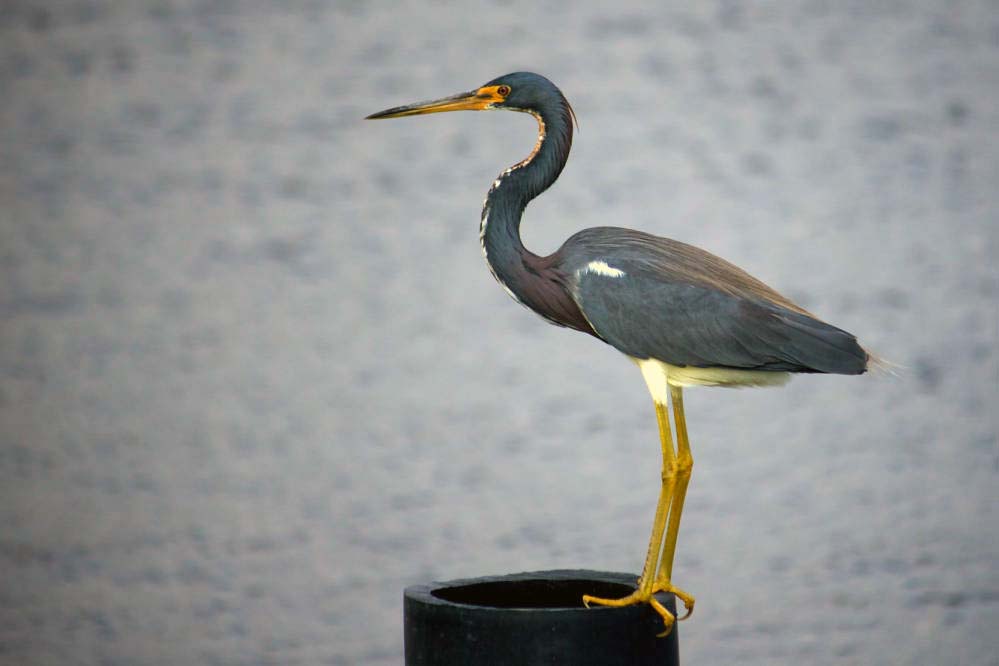
Initially known as the “Louisiana Heron,” the Tricolored Herons are among the smaller members of the Ardeidae family. These herons are commonly found in the coastal regions of the Americas.
Both sexes of the adult Tricolored Herons are identical, lacking any sexual dimorphism. They have a bluish-grey head, neck, and back, while their underbody is white in contrast. The upper part of their bill is grey, and the lower one is orange.
Tricolored Herons have long, dark legs all year round, which turns yellow in the breeding season. They also grow some dark plumes behind their neck in breeding seasons.
Torresian Crow (Corvus orru)
Also referred to as the “Papuan Crow” and “Australian Crow,” the Torresian Crows are a large crow species belonging to the corvid family. These birds are commonly found in Australia and the islands of Indonesia and Papua New Guinea nearby.
In appearance, Torresian Crows are quite similar to their smaller relatives, Little Crows, but have a more robust bill. They have a glossy black plumage, with a dull patch on their chest and hackles on their throat. Their legs and feet are quite long and dark, along with a broad, square-ended tail.
The feathers on the neck of these crows are white at the base, while their eyes are bright lemon yellow. Like most corvids, they also lack sexual dimorphism.
Toco Toucan (Ramphastos toco)
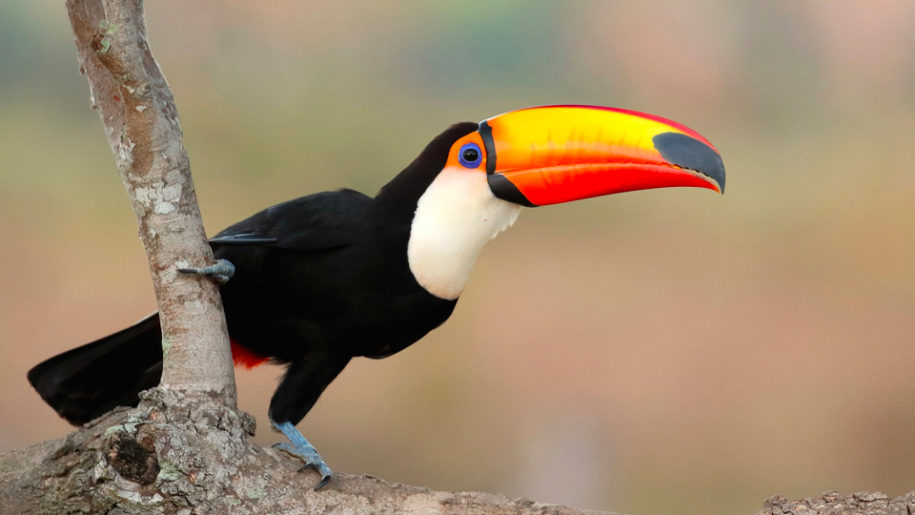
Also known as “Giant Toucan,” the Toco Toucans are the largest member of the toucan family. These toucans are native to South America and are a popular attraction at zoos.
Toco Toucans have two recognized subspecies and mainly black plumage, much like that of all other toucans. Only their face and throat are colored in a white patch, with a large, orange bill, with a reddish base and a dark spot on the tip.
The irises of these toucans are bluish, with orangish shade surrounding them. The adult males are larger in size than their female counterparts, but all that’s all the external difference you can see between the sexes.
Turquoise Jay (Cyanolyca turcosa)
Belonging to the family of the corvids, the Turquoise Jays are a jay species found exclusively in South America, particularly in Peru, Colombia, and Ecuador. They’re a resident species that inhabit humid forests with thickly tangled trees and like to travel in mixed flocks of jays.
Like the other jay species, Turquoise Jays are also sexually monomorphic, with no obvious external differences between the adult sexes. True to their name, these jays have a mainly turquoise plumage with a black bill, chin, underwings, and undertail.
Their irises are dark brown, while the legs and feet are all black. They primarily feed on insects, eggs of other birds, and berries.
Turquoise Parrot (Neophema pulchella)
Turquoise Parrots are a small, lightweight parrot species that are endemic to the savannah and open woodlands of Australia.
The adult Turquoise Parrots are sexually dimorphic in their plumage. The males have a characteristic turquoise blue face with a green head, wings with a blue patch, and yellow underparts.
On the other hand, their female counterparts have duller plumage and have lesser yellow on their body. However, both sexes are sized similarly and weigh roughly the same.
Turquoise Parrots are primarily ground-foragers, looking for seeds to munch on. They’re highly gregarious and often gather in large flocks to hunt for food.
Torresian Imperial Pigeon (Ducula spilorrhoa)
Popularly known as the “Nutmeg Pigeon,” the Torresian Imperial Pigeons are a pied pigeon species endemic to Australia. These pigeons prefer to inhabit mangroves, scrubs, savannahs, and woodlands within their range.
Torresian Imperial Pigeons have a large, plump body with mainly white plumage, with black eyes, undertail, and lower flight feathers. Both adult sexes appear similar in size and plumage, displaying sexual monomorphism.
Tawny-bellied Hermit (Phaethornis syrmatophorus)
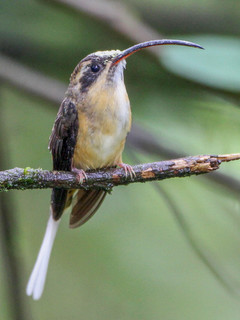
The Tawny-bellied Hermits are a South American hummingbird species that mostly inhabit the mountain forests of Colombia, Peru, and Ecuador.
Tawny-bellied Hermits have two recognized subspecies and have a dark head and upper parts, with an orange-colored belly and rump. Both sexes look alike; only the females have a paler belly.
The diet of Tawny-bellied Hermits consists mainly of nectar and arthropods.
Toucan Barbet (Semnoris ramphastinus)
Toucan Barbets are a South American barbet species that are closely related to toucans. They are one of the most attractively colored barbets and inhabit humid montane forests.
Toucan Barbets have a robust body with a black crown, a yellow bill tipped with black, red eye-rings, a light blue collar, and white and black spots at the back of their head.
The rest of their body is equally striking, with a red breast, belly, and green rump, dark green wings and tail, and grey wing patches. Both sexes of adults appear similar to one other; only the females are slightly duller than their male counterparts.
Toucan Barbets are frugivores, eating a variety of fruits along with other plant matters occasionally.
Conclusion: Birds That Start With T
It is my bird-mission to create a listing of birds that start with the letter “T”. This means it will be an ever-growing list (much like the ever-expanding universe) of bird species.
When complete, visitors can use this list to have a fuller understanding of avian species in our world. I have found that having in-depth knowledge in one area is only truly valuable when you share that knowledge with others.
If you are interested, please help contribute your sightings of birds that start with the letter “T”.
There we go! I just wanted to thank you for taking the time to read this article. I hope that you found value in it and that you can use it as a launching point for your own research.
If you want, I’d love it if you shared this post with your network and helped spread the word about birds that start with the letter T.
Thanks again!
Birds By Alphabet (A-Z List)
Birds that Start with A
Birds that Start with B
Birds that Start with C
Birds that Start with D
Birds that Start with E
Birds that Start with F
Birds that Start with G
Birds that Start with H
Birds that Start with I
Birds that Start with J
Birds that Start with K
Birds that Start with L
Birds that Start with M
Birds that Start with N
Birds that Start with O
Birds that Start with P
Birds that Start with Q
Birds that Start with R
Birds that Start with S
Birds that Start with T
Birds that Start with U
Birds that Start with V
Birds that Start with W
Birds that Start with X
Birds that Start with Y
Birds that Start with Z
